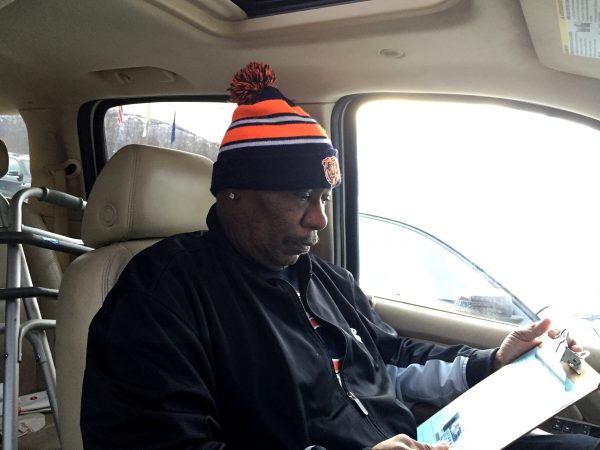
The Solutions Desk looks beyond Alaska’s problems and reports on its solutions – the people and programs working to make Alaska communities stronger. Listen to more solutions journalism stories and conversations, and share your own ideas here.
This is part two of a series about a man on the brink of homelessness. Find the first part here.
When Anchorage resident Dion Wynne was unexpectedly hospitalized for more than a month last fall, he realized he was going to have financial difficulties. His medical providers called for backup.
“They’d seen what I was going through and the stress that I was having that I may have to move out of my home,” he said. “So, they said, ‘We think we need to get the social worker in.'”
Dion wasn’t going to be able to return to work any time soon, and he knew he wouldn’t be able to cover all of his expenses. The social worker helped him figure out which programs he could apply for and which he couldn’t.
“I filled out all that paperwork, and I received [public assistance],” he recalled. “They gave me Food Stamps. They put me on Medicaid, and they let my daughter be on Medicaid.”
[Related: Some old solutions still work – helping people buy food with SNAP]
Though it helped with some things, it wasn’t enough to cover his rent.
For confidentiality reasons, Dion’s social worker couldn’t talk to me directly to tell me all of the resources she and other caseworkers try to access for Dion and others. Instead, she sent me to Anchorage’s Aging and Disability Resource Center. It’s the first stop for lots of people in the city who are seeking rental assistance.
“We get so many requests” for help, said ADRC resource specialist Jasmine Bracey. “I want to say each of us probably get like 10 calls a day, maybe, between all three of us.” And that’s just from people in Anchorage who know about their organization.
Despite the agency’s name, the workers counsel anyone who is trying to find resources in Anchorage. Sometimes, but not always, the ADRC has a small pot of federal money that they can give to people for rental assistance. The amount varies from year to year, but the U.S. Department of Housing and Urban Development provided $141,903 for rental assistance statewide in FY2017.
Before ADRC can give someone some of the money, the resource specialists have to see if the person is eligible. A primary qualification is employment – the person has to have worked in the past 30 days for most rental assistance. But what about situations like Dion’s, where he couldn’t work because of an illness?
“I don’t really know what would happen,” Jasmine said. “Because they wouldn’t be able to get assistance if they hadn’t worked in that last 30 days.”
 “The reason that they have to work is they have to show that they’re sustainable,” explained Jasmine’s colleague, Karla Wright.
“The reason that they have to work is they have to show that they’re sustainable,” explained Jasmine’s colleague, Karla Wright.
For most rental assistance programs, a person can only get help once in their life. Unlike some forms of public assistance, it doesn’t provide consistent, sustained support.
“The whole point in this program is that someone has hit a speed bump, and we’re helping them get over that speed bump,” Wright said. The person has to be able to demonstrate that they can continue forward without more help paying their rent.
Dion hit a speed bump when he was hospitalized for over a month, had his big toe amputated, and couldn’t quickly go back to work. His unique situation disqualified him from receiving some avenues of assistance.
Short-term solutions don’t help all of the people, all of the time. That’s why Karla and Jasmine work with people to develop longer-term solutions for maintaining housing, which includes reassessing how they spend their money. They have conversations about budgeting and refer people to financial literacy classes.

“When people are writing out their income, it’s like, ‘Wow, I spend like $700 on just my car,’ or $200 on a phone bill. So then it kind of lets people see what they’re really spending their money on, so then we get to talking about things like that,” Jasmine said. Oftentimes people develop their own solutions when talking through it all.
For Dion, he can’t really cut many more expenses. He drives an aging car, most of his personal belongings fit into a couple rooms. His utilities are included with his rent.
[Related:How to end homelessness in Anchorage, together]
Karla said the real solution for preventing homelessness for many of the people who are living paycheck to paycheck is to not deny when they are in dire straits.
“I think the key is–and we tell people this all the time–is communication,” Karla said. “If you know that you’re not going to be able to pay your rent, for whatever reason, instead of waiting for that eviction notice to get put on your door or to be handed to you, go ahead and try to be proactive. Go ahead and give us a call before that day, and talk to your landlord.”
That’s what Dion has been doing since the beginning — trying to be proactive. The first step he took was speaking to his landlord, and the result was positive.
“She was supportive of me because she knew what my goal was as far as opening up a foster home, and she was supportive of that,” he said.
The landlord is willing to wait while Dion tries to pull together resources. But he still needs help. He can’t access federal rental assistance so he’s turning to the next resource Karla and Jasmine often suggest — the faith community.
Join Dion on the next step of his journey as he tries to stay in his housing by subscribing to the Solutions Desk podcast on iTunes, Stitcher, Google Play, or NPR.
Do you have other suggestions for people struggling to pay their rent? Add them to the comments section.
Anne Hillman is the healthy communities editor at Alaska Public Media and a host of Hometown, Alaska. Reach her at ahillman@alaskapublic.org. Read more about Anne here.





